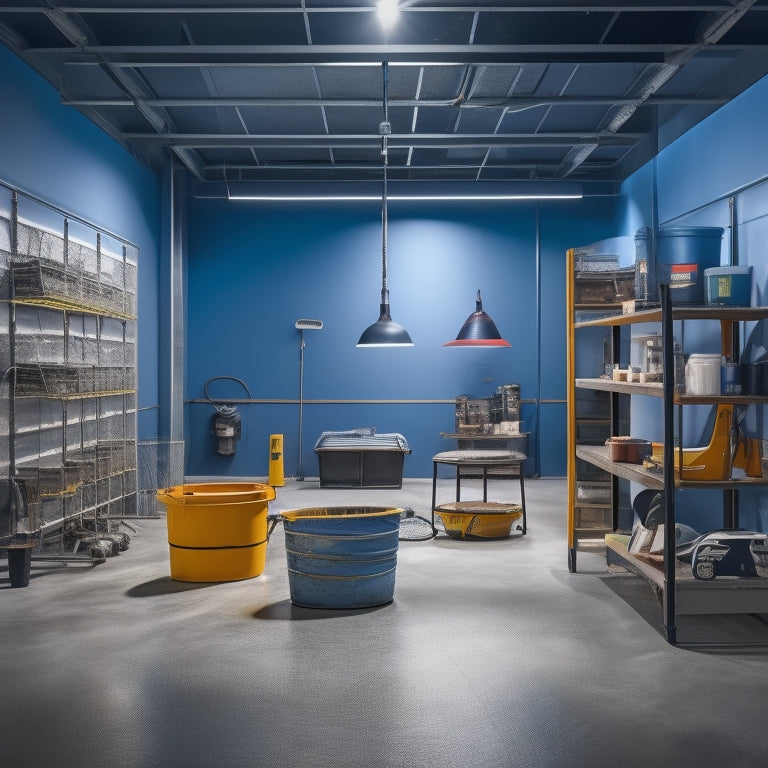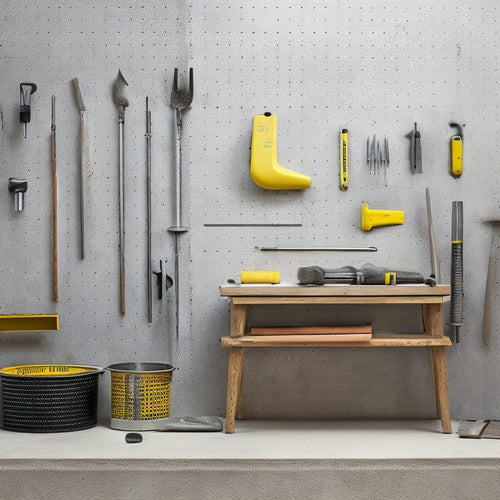
7 Best Tools for Sealing Interior Concrete Floors
Share
You're about to initiate an essential step in protecting and enhancing the aesthetic appeal of your interior concrete floors, and that's selecting the right tools for the job. Evaluating your floor's condition, choosing the right sealant type, and selecting the appropriate applicator tool material are vital steps. Consider your floor's size and shape, evaluate tool durability, and review ease of cleaning before making a decision. Don't forget to check your budget and value ratio to get the best bang for your buck. As you weigh your options, you'll uncover the perfect tools to achieve a durable, high-quality finish that meets your needs and exceeds your expectations.
Key Takeaways
• Choose applicator tools based on floor texture and sealant type, such as microfiber for water-based sealants and lambswool for solvent-based sealants.
• Select tools with durable materials, such as heavy-duty plastics, to withstand harsh conditions and minimize maintenance frequency.
• Consider tool performance and maintenance requirements to ensure efficient project completion and consistent results.
• Evaluate ease of cleaning tools with smooth, non-porous surfaces and detachable parts to reduce damage risk and extend tool lifespan.
• Assess floor size and shape to determine appropriate sealing tools and methods, such as roller extension poles for small floors and ride-on sealers for large floors.
Assessing Floor Condition First
Before applying any sealant, you must thoroughly assess the condition of your interior concrete floor to identify any cracks, stains, or other imperfections that may affect the sealing process. This vital step guarantees a successful sealant application and helps you avoid costly repairs down the line.
To conduct a detailed floor assessment, you'll need to employ effective floor assessment techniques. Start by visually inspecting the floor for visible damage, such as cracks, chips, or discoloration.
Next, use damage inspection methods like sounding or tapping to identify hidden defects. This involves striking the floor gently with a hammer or tapping with a coin to detect hollow sounds, indicating potential delamination or voids.
Additionally, check for moisture issues, oil stains, or other contaminants that may impact sealant adhesion.
Choosing Right Sealant Type
When choosing the right sealant type for your interior concrete floor, you'll need to take into account two critical factors: the sealant's durability and its ability to resist chemicals.
You'll want to assess how well the sealant can withstand foot traffic, cleaning products, and other substances that may come into contact with the floor.
Sealant Durability Factors
You'll need to contemplate several key factors that impact the durability of your sealant, including its chemical composition, finish, and intended use, to choose the right type for your interior concrete floor.
A sealant's chemical composition plays a significant role in its overall performance. Look for a sealant that's formulated with high-quality, non-yellowing resins to guarantee a long-lasting, crystal-clear finish.
The finish you choose will also affect the sealant's durability. For example, a high-gloss finish may be more prone to scratches and wear than a matte finish.
Consider the intended use of your floor to determine the level of durability required. If your floor will be subject to heavy foot traffic or machinery, you'll need a sealant with a longer sealant lifespan.
Additionally, consider the environmental impact of your sealant choice. Opt for a water-based or low-VOC (volatile organic compound) sealant to minimize harm to the environment and improve indoor air quality.
Chemical Resistance Needs
Determining the chemical resistance needs of your interior concrete floor is essential in selecting the right sealant type, as it directly affects the floor's ability to withstand harsh substances and cleaning products.
You'll want to reflect on the types of chemicals that will come into contact with your floor, such as acidic substances, solvents, or alkalis. Conducting chemical resistance testing will help you identify the sealant's ability to resist degradation and damage from these substances.
When evaluating sealant options, you should also take into account the sealant longevity analysis. This involves examining how well the sealant will perform over time, including its ability to maintain its chemical resistance properties.
A sealant with excellent chemical resistance may not be effective if it degrades quickly, compromising its protective abilities.
Selecting Applicator Tool Material
By considering the unique characteristics of your interior concrete floor, you can choose an applicator tool material that effectively picks up and transfers the sealant. This vital decision will impact the overall quality of the sealant application.
You'll want to evaluate tool material options based on their ability to withstand the sealant's chemical properties and the floor's texture.
For instance, if you're working with a water-based sealant, a microfiber applicator might be the best choice. Microfiber tools are gentle on the floor and excel at picking up and distributing water-based sealants evenly.
On the other hand, if you're using a solvent-based sealant, a lambswool applicator could be a better fit. Lambswool tools are more durable and can withstand the solvents' harsher chemicals.
Evaluating the floor's texture is also essential. A foam applicator might be suitable for a smooth floor, while a nap roller could be better suited for a textured or rough surface.
Considering Floor Size and Shape
When you're preparing to seal an interior concrete floor, it's crucial to take into account the floor's size and shape, as these factors will greatly influence your tool selection and application strategy.
You'll need to think about how to efficiently cover large floor areas and navigate around obstacles, as well as how to effectively seal complex shapes and corners.
Floor Dimension Considerations
Your floor's size and shape play a crucial role in selecting the right sealing tools, as larger areas may require more extensive equipment or multiple applications. When evaluating your floor's dimensions, consider the floor layout and how it will impact your sealing methods. A larger floor may require more sealing solution, whereas a smaller floor may only need a single application.
| Floor Size | Recommended Tool | Sealing Method |
|---|---|---|
| Small (<100 sqft) | Roller extension pole | Single application |
| Medium (100-500 sqft) | Walk-behind sealer | Multiple applications |
| Large (>500 sqft) | Ride-on sealer | Industrial-grade equipment |
| Irregular shapes | Handheld sealer | Custom application |
As you assess your floor's dimensions, consider the tools and methods that will best suit your needs. A small floor may only require a roller extension pole, while a large floor may necessitate a ride-on sealer. By understanding the relationship between your floor's size and shape and the sealing tools and methods, you can guarantee a successful and efficient sealing process.
Complex Shape Challenges
You'll encounter unique challenges when sealing interior concrete floors with complex shapes, particularly those that feature curved lines, angled corners, or irregular boundaries. These shapes require specialized tools and techniques to guarantee a seamless seal.
When working with complex shapes, it's vital to take into account the adhesive compatibility of your chosen sealant with the concrete surface. This guarantees a strong bond that can withstand foot traffic and environmental factors.
Additionally, the surface texture of the concrete floor plays an important role in sealant application. Rough or porous surfaces may require additional preparation steps, such as grinding or etching, to create a suitable surface for sealing.
In these cases, specialized applicators or tools with adjustable nozzles can help you navigate tight spaces and irregular shapes. By selecting the right tools and taking into account the unique characteristics of your floor, you can overcome complex shape challenges and achieve a professional-looking seal.
Evaluating Tool Durability Factor
How long will your concrete floor sealing tools withstand the rigors of repeated use and harsh environmental conditions?
When evaluating tool durability, you want to guarantee that your investment will last for a long time, performing at peak efficiency with minimal maintenance. Analyzing tool performance under various conditions is essential. You need to take into account factors such as the material quality, build, and design of the tool. Will it withstand exposure to chemicals, heavy foot traffic, or extreme temperatures?
When evaluating tool durability, you should also reflect on maintenance frequency. How often will you need to clean, lubricate, or replace parts? A durable tool will require less frequent maintenance, saving you time and resources.
Look for tools with durable components, such as stainless steel or heavy-duty plastics, that can withstand the demands of sealing concrete floors. By taking into account tool performance and maintenance frequency, you can make an informed decision about the best tool for your needs, guaranteeing that your concrete floor sealing projects are completed efficiently and effectively.
Reviewing Ease of Cleaning Tool
A well-designed concrete floor sealing tool should feature easy-to-clean components, guaranteeing that dirt, grime, and leftover sealant don't compromise its performance over time.
As you analyze different tools, consider the cleaning frequency you'll need to maintain peak performance. Look for tools with smooth, non-porous surfaces that can be easily wiped down or washed with soap and water. Some tools may also feature detachable parts, making it easier to clean hard-to-reach areas.
When evaluating a tool's cleaning ease, think about the type of sealant you'll be working with. If you'll be using a water-based sealant, you may prioritize tools with water-resistant components. For solvent-based sealants, you'll want a tool that can withstand harsh cleaning chemicals.
Regular tool maintenance is essential to extending the life of your sealing tool. By choosing a tool that's easy to clean, you'll reduce the risk of damage and guarantee consistent results.
Consider the time and effort you'll save with a low-maintenance tool, and prioritize ease of cleaning in your evaluation.
Checking Budget and Value Ratio
When evaluating concrete floor sealing tools, your budget plays a critical role in determining the best value for your investment.
It's essential to assess the tool's performance against its cost. You want to guarantee that the tool you choose provides the desired results without breaking the bank. To do this, you'll need to employ value assessment techniques to compare the cost of the tool with its benefits.
One approach is to calculate the cost per square foot of the tool's coverage area. This will give you a clear understanding of how much you're paying for each area of your concrete floor.
Additionally, consider the tool's durability and lifespan, as well as any maintenance or replacement costs. By doing so, you can identify budget-friendly options that provide the best value for your money.
Frequently Asked Questions
Can I Seal a Concrete Floor With an Existing Epoxy Coating?
When you're dealing with an existing epoxy coating on a concrete floor, you'll need to assess epoxy compatibility before applying a new sealant.
Confirm the surface is clean and free of contaminants through proper surface preparation.
If the epoxy is still in good condition, you might be able to apply a compatible sealant on top.
However, if the epoxy is damaged or deteriorated, you'll need to remove it entirely before sealing the concrete floor.
Do I Need to Prime the Floor Before Applying a Sealant?
Did you know that 75% of concrete floors fail due to improper preparation?
When it comes to sealing your concrete floor, you're wise to wonder if priming is necessary. The answer is yes. Priming guarantees a strong bond between the sealant and concrete, reducing delamination risks.
By incorporating preparation techniques like priming, you'll reap benefits like enhanced durability and stain resistance.
Don't skip this essential step – prime your floor to assure a successful sealant application.
How Long Does It Take for a Sealant to Fully Cure?
You're probably wondering how long it takes for a sealant to fully cure. The answer depends on the type of sealant you're using.
Acrylic sealants typically cure within 1-2 hours, while polyurethane and epoxy-based sealants can take 24-48 hours.
Silane and siloxane sealants may require 7-14 days to fully cure.
Make sure to follow the manufacturer's instructions for the specific sealant type you're using, as cure times can vary.
Can I Use a Sealant on a Floor With High Foot Traffic?
It's not a coincidence that you're wondering about using a sealant on a high-traffic floor - it's a top concern for many. You're right to think about it, too.
The truth is, not all sealants are created equal when it comes to durability. If you want a sealant that can withstand heavy foot traffic, look for ones specifically designed for high-traffic areas.
These sealants are formulated to resist wear and tear, ensuring your floor stays protected and looking great despite the constant flow of people.
Are There Any Eco-Friendly or Non-Toxic Sealant Options Available?
When you're looking for a sealant, you'll be glad to know you've got eco-friendly alternatives and non-toxic options available.
You can opt for plant-based sealers, like soy or corn oil-based products, that are biodegradable and low in VOCs.
Another choice is water-based acrylic sealers, which are free from harsh chemicals and toxins.
These alternatives provide a safe, environmentally responsible solution for your high-traffic floor, while still offering excellent protection and durability.
Conclusion
You've made it to the final step in selecting the best tool for sealing your interior concrete floor.
Remember, a well-chosen sealant and applicator can make all the difference in the floor's durability and appearance.
Curiously, according to the American Concrete Institute, a properly sealed concrete floor can increase its lifespan by up to 50%.
By considering the factors outlined above, you'll be well on your way to achieving a beautifully sealed floor that will last for years to come.
Related Posts
-

3 Best Hand Tools for DIY Concrete Construction
When tackling a DIY concrete construction project, you'll need three essential hand tools to achieve a professional-l...
-

10 Must-Have Tools for Concrete Repair Organization
You'll need a solid organization system to keep your concrete repair tools and materials within easy reach, protected...
-

5 Tips for Splitting Concrete With Second-Hand Tools
When splitting concrete with second-hand tools, you'll need to be strategic to avoid wasting time, money, and putting...


